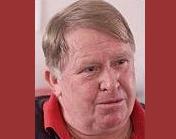Presented by
This week's column:
Sprint Technique and Training
Sept. 14, 2011
 Hi, Bill: Could you please go over the fundamentals of sprinting? What aspects of the skating technique change when one transfers over from cruising speed to max speed? How is cadence, arm swing, knee bend, underpush, back bend, recovery leg, etc. affected? What drills can I do to increase top end speed? Thanks for your help! - Rob from Oklahoma.
Hi, Bill: Could you please go over the fundamentals of sprinting? What aspects of the skating technique change when one transfers over from cruising speed to max speed? How is cadence, arm swing, knee bend, underpush, back bend, recovery leg, etc. affected? What drills can I do to increase top end speed? Thanks for your help! - Rob from Oklahoma.
Hi, Rob from Oklahoma: I’ve spent the last three months speeding up skaters on the Indonesian team, so it’s a good question to ask me now. To begin with, let me repeat what I have said before in this column: the keys to straight-line speed on the road are a low position with a full extension side push and a high back-arm action — this according to two studies I was involved in during my university days.
So let’s break this down:
1) Arm swing
Your arms must swing back until they are fully extended behind you. At that point, they form an angle of about 45 degrees with your back. Then they swing forward until your arm comes across to the other side of your face.
What you do with your arms is just as important as what you do with your feet when sprinting. In fact, arm swing is probably the thing that makes the biggest difference when you go from cruising to sprinting speed.
2) Low position
You‘ve got to be in a low skating position to produce top end speed. If you are too upright, you cannot generate full power. This means bending at the knees and waist until your back is parallel to the ground. Your back should form an angle of about 90 degrees and no more than 105 degrees. World champions Yann Guyader and Peter Michael often go lower than this.
3) Recovery loop
After each push comes the D-shaped recovery loop. You do this by bringing the foot back and behind the body and pointing the toe toward the opposite (support) skate while keeping the hips closed. When the foot is behind the body, it should be kept high so the leg is at least parallel to the ground. (For sprinters, the angle is about 95 degrees.) The knee of the trailing leg should be well behind the support knee. (In other words, there should be a longitudinal gap between the knees.) Then, you use your hip muscles to pull the trailing leg forward until it is next to the support knee. Finally, you are ready to setdown your wheels and start another push.
4) Knees and toes
Your knees should be bent sufficiently so your support knee is over the top of your toes.
5) Underpush
If you double push, and if you are transferring your body weight correctly, your underpush will become more pronounced.
My take on cadence
Cadence is not a word I have ever used as a coach. Cadence, which is synonymous with foot speed, can be a factor in the first 30 meters, as long as you are stretching forward rather than running in place.
The great Italian sprinter Gregorio Duggento combined size, power and a fast cadence to win multiple world titles. But you either have fast twitch fiber or not . Duggento had it but he could not go much past 500 meters.
On the other hand, New Zealand’s Kalon Dobbin, who won more 300-meter track titles than the Italian, was not big on cadence, but very smooth and precise technically. Another example of this is the Australian Joe Askew. He came to me as “Joe the Slugger” in the mid-1980s when he and his brother Mark used to tow everyone around the track in long distance events only to get beat in the sprint. He wanted to be the next 20K world champion. But I changed his mind and turned him into a sprinter. Five months later, he won the 300-meter time trial. Once again, technique trumped cadence.
In fact, cadence is well down the list of factors in sprinting. Spain’s Joseba Fernandez broke Dugento’s 200-meter record this year not with a fast cadence but with precise technique that wasted no effort.
Drills for sprints
1) Vibrations
Sprint for 10 seconds, rest for 30 seconds. Repeat 10 times, three times a week. This stimulates the neuromuscular system.
2) ATP sprints
Skate for six seconds at maximum speed (100 percent effort). Then give yourself two minutes of passive recovery. Mix standing starts with slow rolling starts. Repeat 10 times.
3) Plyometrics/offskate training
Cheers, Bill

World renowned coach Bill Begg shares his vast knowledge of skating in his weekly advice column, "Ask Bill Begg!" ... Every Wednesday on the Inline Planet.
p s